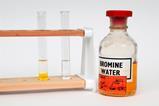Use these tips and resources to link UN sustainable development goal 3 and biology topics on health and disease to your lessons on anticancer drugs

Chemists design, create and modify molecules to produce new and useful materials such as pharmaceuticals. Research and development of new medicines and vaccines against communicable and non-communicable diseases is vital in helping to achieve the UN’s sustainable development Goal 3: ensure healthy lives and promote well-being for all at all ages.
Students aged 14–16 will be familiar with health and disease topics from their biology studies. While students may associate these topics solely with biology, it is important for them to understand the roles chemistry and chemists play in the process of drug discovery, design and development to help prevent and treat some of the world’s most serious diseases. Discussing Goal 3 when you teach any chemistry topic that has links to medicinal chemistry will help you achieve this.

This article is part of the Sustainability in chemistry series, developed to help you integrate the UN’s sustainable development goals into your teaching of chemistry. It supports Goal 3: ensure healthy lives and promote well-being for all at all ages.
Put it into context
While students will be aware of the Covid-19 pandemic, which has impacted all of their lives, they may not be as aware of many epidemics around the world. You can find some key facts on the epidemics of HIV/AIDS, tuberculosis, malaria, other tropical diseases and waterborne diseases on the World Health Organization’s website. Ending these epidemics by 2030 is a key target of Goal 3. Discuss these epidemics and ask why it is important for countries to work together to solve such problems.
Prior to the pandemic, the UN said that progress was being made in health areas but not fast enough to meet the targets by 2030; one target being reducing premature mortality from non-communicable diseases such as cancer. However, due to the disruption caused to health services, much of that progress has stopped, even reversed. Cancer screening in particular has been affected and unfortunately, the UN predicts there will be a 100% increase in malaria deaths in sub-Saharan Africa.
Another target of Goal 3 is to reduce the number of deaths and illnesses from air and water pollution by 2030. Air pollution is an important section of the 14–16 chemistry curriculum so discussing Goal 3 here will provide context. See the article and resource on Goal 11: sustainable cities and communities for air pollution teaching ideas.
Download this
Transition metals and anticancer drugs worksheet, for age range 16–18
Use this worksheet to recap shapes of complexes, check understanding of anticancer drugs and provide students with some history behind cisplatin.
Download the student worksheet as MS Word or pdf and the answer sheet as MS Word or pdf.
Download the student worksheet and answer sheet from the Education in Chemistry website: rsc.li/xxxxxxx
Put it into practice
While vaccines, antibody tests and antigen tests are all over the news, they aren’t on chemistry specifications. However, just because something is not on a specification, that doesn’t mean it’s not worth teaching and it may help to enrich your curriculum.
There are some great infographics from Compound Interest that you can use with your students to help them appreciate some of the chemistry behind the Covid-19 pandemic. You could use them to help deliver a lesson on the chemistry behind vaccines. If you are short on curriculum time, you can use them in an enrichment activity as part of a science club, as wider reading for a piece of homework or as the basis of a discussion in form time.
Introduce cross-curricular links
Goal 3 provides you with the opportunity to link nicely to the health and disease units of biology. Provide students with wider reading on the development of a malaria vaccine to compliment 14–16 students’ studies of malaria. Here you can discuss the importance of chemistry and link to the Goal 3 target of ending the malaria epidemic.
One way of reducing deaths from non-communicable diseases such as cancer, is by using anticancer drugs. Cisplatin is the anticancer drug taught to most 16–18 students.
When teaching anticancer drugs, highlight the role chemists play in their design and development and discuss with students the balance between the pros of anticancer drugs and their adverse side effects. Remind students there are many types of cancer and therefore many different treatments. Point out that cisplatin does not work for all types of cancer and that lots of anticancer drugs have been developed since cisplatin.
Use the article and resource designing anticancer drugs and follow up with the worksheet above, to help students apply their knowledge of cisplatin to other platinum anticancer drugs and gain an understanding of how anticancer drugs are developed. You could also give students this article on asplatin.
Get more resources
- Find experiment notes and a student sheet, suitable for 16–18 leaners, on the Analysis of aspirin tablets.
- Link to careers with this video profile of a research assistant helping to detect diseases, such as cancer, earlier.
- Use this feature on 4D printing to show how developments in chemistry and technology are advancing medicine, with a worksheet activity exploring the chemistry of polymers used in 3D and 4D printing.
- Chemistry, medicine and genetic analysis will help you highlight the importance of the sciences working alongside each other to make lifesaving discoveries.
Check out the rest of the Sustainability in chemistry series.














No comments yet